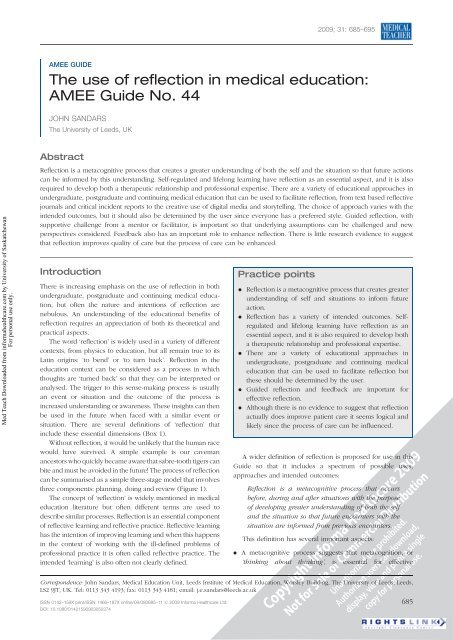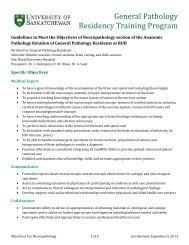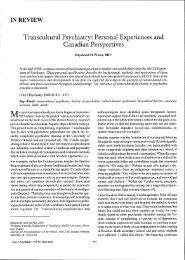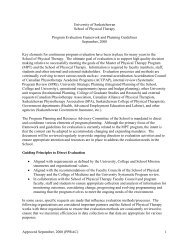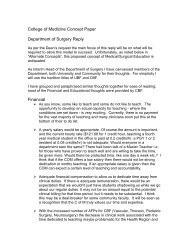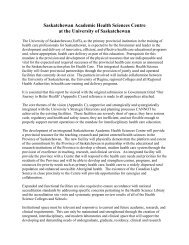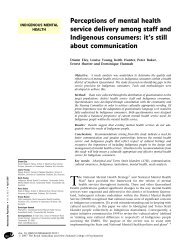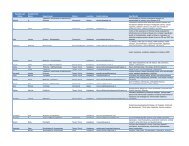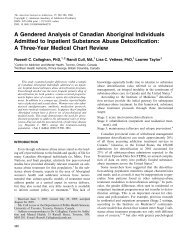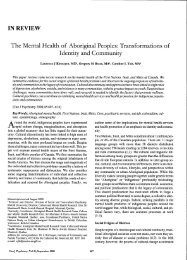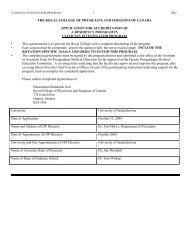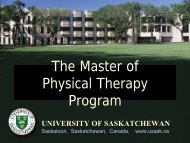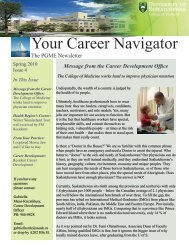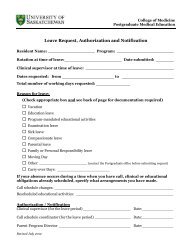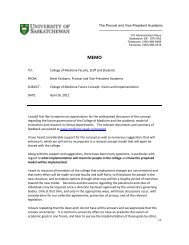The use of reflection in medical education: AMEE Guide No. 44
The use of reflection in medical education: AMEE Guide No. 44
The use of reflection in medical education: AMEE Guide No. 44
You also want an ePaper? Increase the reach of your titles
YUMPU automatically turns print PDFs into web optimized ePapers that Google loves.
Reflection <strong>in</strong> <strong>medical</strong> <strong>education</strong>Med Teach Downloaded from <strong>in</strong>formahealthcare.com by University <strong>of</strong> SaskatchewanFor personal <strong>use</strong> only.possibility that some <strong>in</strong>dividuals can <strong>in</strong>crease their selfrum<strong>in</strong>ationbehaviour where they are not able to shut <strong>of</strong>fthoughts about themselves. This is an anxious attention to selfand they may constantly question their motives and becomeunsure about their actions.Important ethical considerations about confidentiality<strong>in</strong>clude who has access to the <strong>reflection</strong> and for whatpurpose. Many <strong>education</strong>al programmes and pr<strong>of</strong>essionalrevalidation schemes <strong>in</strong>sist on <strong>in</strong>dividuals keep<strong>in</strong>g a reflectivediary and <strong>of</strong>ten the entries are <strong>use</strong>d for assessment. <strong>The</strong>re isa tension <strong>in</strong> these circumstances s<strong>in</strong>ce assessment usuallyrequires evidence <strong>of</strong> ‘deep’ <strong>reflection</strong> but it is this type <strong>of</strong>significant experience that exposes the vulnerability <strong>of</strong> the<strong>in</strong>dividual. This is particularly important when the assessor isalso the facilitator or mentor.<strong>The</strong>re are no easy answers to these problems but the issuesrequire careful consideration. It has to be expected that some<strong>in</strong>dividuals may require emotional and psychological supportbeyond the <strong>in</strong>itial reaction. It is good practice to providesupport service contact numbers to <strong>in</strong>dividuals and forfacilitators to be aware <strong>of</strong> the available support services.<strong>The</strong> <strong>education</strong>al impact <strong>of</strong><strong>reflection</strong> <strong>in</strong> <strong>medical</strong> <strong>education</strong>A recent systematic review <strong>of</strong> <strong>reflection</strong> and reflective practice<strong>in</strong> health care pr<strong>of</strong>essional <strong>education</strong> and practice highlightedthat, to date, there was no conv<strong>in</strong>c<strong>in</strong>g evidence that <strong>reflection</strong>enhanced competence through a change <strong>in</strong> cl<strong>in</strong>ical practiceor improved patient care (Mann et al. 2007). However, theauthors noted that there was a plausible potential benefit.<strong>The</strong>re was evidence that <strong>reflection</strong> was associated with adeeper approach to learn<strong>in</strong>g that allowed new learn<strong>in</strong>g to be<strong>in</strong>tegrated with exist<strong>in</strong>g knowledge and skills. An importantoutcome that they identified was that diagnostic reason<strong>in</strong>g <strong>of</strong>complex and unusual cases could be improved by <strong>reflection</strong>.A limited literature review <strong>of</strong> <strong>reflection</strong> <strong>in</strong> undergraduate<strong>medical</strong> <strong>education</strong> was performed for this <strong>Guide</strong> and 21articles were identified that were relevant to the purpose <strong>of</strong> thereview. A variety <strong>of</strong> methods to foster <strong>reflection</strong> wereidentified but only one study compared different approaches(Baernste<strong>in</strong> & Fryer-Edwards 2003). This study had the aim <strong>of</strong>identify<strong>in</strong>g whether writ<strong>in</strong>g a critical <strong>in</strong>cident report, a one-toone<strong>in</strong>terview, or a comb<strong>in</strong>ation, was more effective <strong>in</strong> elicit<strong>in</strong>g<strong>reflection</strong>. <strong>The</strong> conclusion was that an <strong>in</strong>terview with a tutorwas the most effective for <strong>reflection</strong> on pr<strong>of</strong>essionalism. <strong>The</strong>rehave been no longitud<strong>in</strong>al studies dur<strong>in</strong>g the <strong>medical</strong> schoolexperience and there is no evidence <strong>of</strong> the benefits <strong>of</strong><strong>reflection</strong> on their long-term development, especially <strong>in</strong> theirsubsequent cl<strong>in</strong>ical care. Reflection by undergraduate <strong>medical</strong>students <strong>in</strong>creased self-reported measures <strong>of</strong> self-awareness,pr<strong>of</strong>essional th<strong>in</strong>k<strong>in</strong>g skills and the skills required for <strong>in</strong>timateexam<strong>in</strong>ations. Four studies described positive objective outcomes,with <strong>in</strong>creased skills <strong>in</strong> <strong>reflection</strong> and diagnosticth<strong>in</strong>k<strong>in</strong>g (Sobral 2000), pr<strong>of</strong>essional identity (Niemi 1997),scores <strong>in</strong> <strong>medical</strong>-humanism aptitude (Wiecha et al. 2002) andf<strong>in</strong>al exam<strong>in</strong>ation results for obstetrics and gynaecology(Lonka et al. 2001). In conclusion, students found <strong>reflection</strong>was <strong>use</strong>ful and the implementation <strong>of</strong> <strong>reflection</strong> <strong>in</strong>creasedboth self-reported and objective outcomes on learn<strong>in</strong>g andpr<strong>of</strong>essional development.How to implement <strong>reflection</strong> <strong>in</strong><strong>medical</strong> <strong>education</strong><strong>The</strong>re are a wide variety <strong>of</strong> different approaches to implement<strong>reflection</strong> <strong>in</strong> <strong>medical</strong> <strong>education</strong> and these will depend on the<strong>in</strong>tended outcome but also on the constra<strong>in</strong>ts <strong>of</strong> the environmentwith<strong>in</strong> which <strong>reflection</strong> takes place, such as therequirements <strong>of</strong> an academic course.Educational strategies todevelop <strong>reflection</strong><strong>The</strong> self-regulated learn<strong>in</strong>g model (Zimmerman & Schunk2001) provides a <strong>use</strong>ful framework to guide <strong>education</strong>alstrategies that can be <strong>use</strong>d to develop <strong>reflection</strong>. This modelalso helps educators to understand the potential barriers andhow they can be overcome.a) Motivation for <strong>reflection</strong>Successful <strong>reflection</strong> requires the <strong>in</strong>dividual to recognise theimportance <strong>of</strong> <strong>reflection</strong> for both personal growth andpr<strong>of</strong>essional development. Motivation is dependent on sett<strong>in</strong>gclear goals, <strong>in</strong>ternal factors and external factors. Goal sett<strong>in</strong>gmay be difficult if the <strong>in</strong>tended outcome <strong>of</strong> <strong>reflection</strong> is notexplicit. Often the learner is <strong>in</strong>structed ‘to reflect’ but with littleor no explanation <strong>of</strong> the purpose. It is helpful to <strong>in</strong>itiallyprovide <strong>in</strong>formation about the nature and outcomes <strong>of</strong><strong>reflection</strong>, <strong>in</strong>clud<strong>in</strong>g its importance for pr<strong>of</strong>essional practiceand lifelong learn<strong>in</strong>g.<strong>The</strong> ma<strong>in</strong> <strong>in</strong>ternal motivation factors are self-efficacy andthe perceived ease <strong>of</strong> the task. <strong>The</strong>se factors are essential toconsider, especially when <strong>reflection</strong> is <strong>in</strong>itially <strong>in</strong>troduced tolearners. Motivation can be <strong>in</strong>creased by encouragement andby gradually <strong>in</strong>creas<strong>in</strong>g the reflective tasks, such as beg<strong>in</strong>n<strong>in</strong>gwith only notic<strong>in</strong>g and then <strong>in</strong>troduc<strong>in</strong>g the completereflective process.<strong>The</strong> overall external <strong>education</strong>al environment with<strong>in</strong> which<strong>reflection</strong> is expected to occur is an important motivationfactor. Assessment appears to drive learn<strong>in</strong>g, from exam<strong>in</strong>ations<strong>in</strong> undergraduate students to certification and revalidation<strong>in</strong> postgraduates and cont<strong>in</strong>u<strong>in</strong>g <strong>medical</strong> <strong>education</strong>. <strong>The</strong><strong>use</strong> <strong>of</strong> an assessed portfolio for personal and pr<strong>of</strong>essionalreflective learn<strong>in</strong>g will be different to an <strong>in</strong>formal journal ordiary.b) Metacognitive skills for <strong>reflection</strong>It is essential that an <strong>in</strong>dividual can develop their metacognitiveskills to monitor and evaluate the key aspects <strong>of</strong> <strong>reflection</strong>:notic<strong>in</strong>g, process<strong>in</strong>g and altered action.<strong>No</strong>tic<strong>in</strong>gAn essential first step for an <strong>in</strong>dividual is the recognition <strong>of</strong>when their exist<strong>in</strong>g mental models and personal theories are689
Reflection <strong>in</strong> <strong>medical</strong> <strong>education</strong>Med Teach Downloaded from <strong>in</strong>formahealthcare.com by University <strong>of</strong> SaskatchewanFor personal <strong>use</strong> only.Reflection with this <strong>in</strong>tention seeks to identify andchallenge current belief systems and assumptions. Oftenthere is an awareness <strong>of</strong> strong feel<strong>in</strong>gs associated with aparticular experience and this can lead to deeper question<strong>in</strong>g.<strong>The</strong>se questions <strong>in</strong>clude. What am I feel<strong>in</strong>g and what are my emotions?. Why do I feel like this?. Are there other situations <strong>in</strong> my life or my encounters withothers when I feel the same?. Can I expla<strong>in</strong> why I feel this way?. What are the consequences <strong>of</strong> these emotions for me andfor others?(iii) Reflection to develop pr<strong>of</strong>essional practice. <strong>The</strong> <strong>in</strong>tention<strong>of</strong> this approach to <strong>reflection</strong> is to develop pr<strong>of</strong>essionalexpertise. Research <strong>in</strong>to the nature <strong>of</strong> expertise identifies thatexperts have more elaborate mental models than novices. Thisallows experts to quickly mobilise these models when theyencounter a situation. <strong>The</strong> elaborate models are created byrepeated exposure to a wide variety <strong>of</strong> experiences and theyare also closely <strong>in</strong>terconnected. Development <strong>of</strong> these modelshas not occurred by a random phenomenon but throughrepeated exposure to situations. This is the key to pr<strong>of</strong>essionalexpertise.Pr<strong>of</strong>essional expertise can be developed by encourag<strong>in</strong>grepeated exposure to the field <strong>of</strong> practice and by widen<strong>in</strong>g thisfield with further experiences from related films and literature.A process <strong>of</strong> constant <strong>reflection</strong>-on-action is an essentialrequirement for pr<strong>of</strong>essional expertise and is typical <strong>of</strong> the‘enquir<strong>in</strong>g m<strong>in</strong>d’ that explores and tries to obta<strong>in</strong> multipleperspectives to enrich their view <strong>of</strong> the world. Often there islittle <strong>in</strong> the way <strong>of</strong> written <strong>reflection</strong> but there may be widerang<strong>in</strong>g discussions with colleagues, such as journal clubs andat conference. Some doctors try and make sense by the <strong>use</strong> <strong>of</strong>written <strong>reflection</strong>, either as reflective diaries, reflective storytell<strong>in</strong>gor poems.Future actionIt can be easy to assume that <strong>reflection</strong> is only <strong>in</strong>trospectionwith little outside application. However, the aim <strong>of</strong> <strong>reflection</strong> isto <strong>in</strong>form future actions so that they can be more purposiveand deliberate. An important aspect is to ensure that actionsrespect the context to which they are be<strong>in</strong>g applied, such aswhen evidence based cl<strong>in</strong>ical guidel<strong>in</strong>es are not followedbeca<strong>use</strong> the patient is different to the population <strong>in</strong> which theorig<strong>in</strong>al research was conducted. This <strong>of</strong>ten results <strong>in</strong> furthercycles <strong>of</strong> <strong>reflection</strong> and action when the consequences <strong>of</strong> thisdecision mak<strong>in</strong>g are considered.c) Reflective storytell<strong>in</strong>g and writ<strong>in</strong>g<strong>The</strong>re is a long and ancient history <strong>of</strong> storytell<strong>in</strong>g <strong>in</strong> mostcivilisations. Individuals tell stories to convey their experiencesto others and these stories <strong>in</strong>clude <strong>in</strong>formation, op<strong>in</strong>ions andemotions. It is a natural step for storytell<strong>in</strong>g to be <strong>use</strong>d forreflective learn<strong>in</strong>g s<strong>in</strong>ce an <strong>in</strong>tegral aspect <strong>of</strong> many stories is<strong>reflection</strong> on an experience with the development <strong>of</strong> new<strong>in</strong>sights. <strong>The</strong> process <strong>of</strong> tell<strong>in</strong>g a story, whether written or oral,requires the teller to notice and make sense <strong>of</strong> an experience.<strong>The</strong> presentation <strong>of</strong> the story, either private or with<strong>in</strong> a groupappears to have an important therapeutic aspect which allowsthe learner to release emotion, an essential part <strong>of</strong> thereflective process (Gersie 1997).Storytell<strong>in</strong>g has been <strong>use</strong>d to effectively engage studentsand healthcare pr<strong>of</strong>essionals <strong>in</strong> <strong>reflection</strong> and reflectivepractice (McDrury & Alterio 2003). Individuals <strong>of</strong>ten require<strong>in</strong>itial tra<strong>in</strong><strong>in</strong>g to develop their storytell<strong>in</strong>g skills and astructured approach is <strong>use</strong>ful. A typical sequence for a storyis a beg<strong>in</strong>n<strong>in</strong>g, middle and an end. Usually the beg<strong>in</strong>n<strong>in</strong>g setsthe scene and this is followed by a middle component <strong>in</strong>which the ‘drama unfolds’ and the ma<strong>in</strong> aspects <strong>of</strong> the story arepresented and discussed. <strong>The</strong> end <strong>of</strong> the story usually conta<strong>in</strong>san important message that the storyteller wishes to convey tothe audience. <strong>The</strong>re are close parallels <strong>of</strong> these stages withthe phases required for effective <strong>reflection</strong>.<strong>The</strong> <strong>use</strong> <strong>of</strong> reflective writ<strong>in</strong>g for <strong>reflection</strong> <strong>in</strong> undergraduate<strong>medical</strong> students has been described (DasGupta & Charon2004) and also <strong>in</strong> cont<strong>in</strong>u<strong>in</strong>g <strong>medical</strong> <strong>education</strong> (Bolton 1999).For an example <strong>of</strong> <strong>in</strong>structions to <strong>use</strong> digital storytell<strong>in</strong>gfor reflective learn<strong>in</strong>g, please see Appendix 2, available atwww.<strong>medical</strong>teacher.org.Personal development plans and portfolios<strong>The</strong>re has been <strong>in</strong>creas<strong>in</strong>g <strong>use</strong> <strong>of</strong> structured approaches toboth encourage and assess reflective learn<strong>in</strong>g <strong>in</strong> postgraduateand cont<strong>in</strong>u<strong>in</strong>g <strong>medical</strong> <strong>education</strong> (Rughani 2001). Often theseapproaches are essential components <strong>of</strong> tra<strong>in</strong><strong>in</strong>g, certificationor revalidation. <strong>The</strong> approach requires that learn<strong>in</strong>g needs are<strong>in</strong>itially identified and then decisions are made as to how theseneeds can be met. Reflection is an essential aspect <strong>of</strong> theprocess and this can be <strong>in</strong>cluded <strong>in</strong> the structured approach.For example, there can be several questions that can prompt<strong>reflection</strong> on current knowledge or skills.(i) Identification <strong>of</strong> learn<strong>in</strong>g needs. Most pr<strong>of</strong>essionals willhave a wide range <strong>of</strong> experiences that will enable them toidentify their learn<strong>in</strong>g needs. <strong>The</strong>se <strong>in</strong>clude self-awareness <strong>of</strong>how they respond to situations, such as thoughts about whatsituations they f<strong>in</strong>d challeng<strong>in</strong>g, significant events, feedbackfrom colleagues and patients, prescrib<strong>in</strong>g and referral audits,and quizzes.(ii) Develop<strong>in</strong>g a plan to meet the identified learn<strong>in</strong>gneeds. Several <strong>education</strong>al <strong>in</strong>terventions are chosen andthese are usually prioritised. For example, an identified learn<strong>in</strong>gneed <strong>of</strong> not hav<strong>in</strong>g knowledge about the latest treatment fordiabetes would prompt the learner to seek further <strong>in</strong>formation,such as by attend<strong>in</strong>g a tra<strong>in</strong><strong>in</strong>g course or read<strong>in</strong>g an article.A portfolio provides a collection <strong>of</strong> the various pieces <strong>of</strong>evidence to prove to an assessor that learn<strong>in</strong>g needs havebeen identified but, more importantly, have been met byappropriate <strong>education</strong>al approaches (Moon 1999). It is <strong>use</strong>fulto have all <strong>of</strong> this <strong>in</strong>formation <strong>in</strong> one place but it is also easy toregard a portfolio as not help<strong>in</strong>g the learner. <strong>The</strong> advent <strong>of</strong>e-portfolios has enabled a more flexible and <strong>use</strong>r-friendlyapproach to collection <strong>of</strong> evidence. It is now easier to upload a691
J. SandarsMed Teach Downloaded from <strong>in</strong>formahealthcare.com by University <strong>of</strong> SaskatchewanFor personal <strong>use</strong> only.wide range <strong>of</strong> materials to stimulate <strong>reflection</strong>, such asphotographs or audit reports, to record the <strong>reflection</strong>s and tokeep a dynamic record <strong>of</strong> how these <strong>reflection</strong>s have<strong>in</strong>fluenced pr<strong>of</strong>essional practice.For examples <strong>of</strong> templates to structure <strong>reflection</strong> andquestions to develop deeper <strong>reflection</strong> please see Appendix 1,available at www.<strong>medical</strong>teacher.org.Assessment <strong>of</strong> <strong>reflection</strong>Assessment is a process that requires a judgment to be madeabout the standard <strong>of</strong> an outcome and has relevance for<strong>reflection</strong> <strong>in</strong> <strong>medical</strong> <strong>education</strong>. Formative assessment is an<strong>in</strong>tegral aspect <strong>of</strong> giv<strong>in</strong>g feedback and it also <strong>of</strong>fers theidentification <strong>of</strong> further learn<strong>in</strong>g needs. Summative assessmentoccurs after a period <strong>of</strong> study and this may be required for<strong>reflection</strong>, such as <strong>in</strong> undergraduate course curricula. Studentsdislike the notion <strong>of</strong> assessment <strong>of</strong> their reflective activities,regard<strong>in</strong>g their entries as private but also they are scepticalabout whether the assessment approach can be valid andreliable. Validity considers whether the assessment is measur<strong>in</strong>gwhat it is <strong>in</strong>tended to measure and reliability that the result<strong>of</strong> the assessment is consistent between markers and time.Students readily recognise that written <strong>reflection</strong>, such as <strong>in</strong>reflective diaries, may not be an accurate account <strong>of</strong> thethoughts and emotions <strong>of</strong> the writer.Despite the concerns <strong>of</strong> students, assessment <strong>of</strong> <strong>reflection</strong>may be required for a variety <strong>of</strong> purposes and an overallframework can be <strong>use</strong>ful. Most assessments will <strong>in</strong>corporate‘levels <strong>of</strong> <strong>reflection</strong>’ and this hierarchical model is based on theconcept <strong>of</strong> depth <strong>of</strong> <strong>reflection</strong>. Superficial <strong>reflection</strong> isconsidered to occur when there is only description <strong>of</strong> eventsbut deeper <strong>reflection</strong> <strong>in</strong>cludes a ‘stepp<strong>in</strong>g back’ from eventsand actions with evidence <strong>of</strong> challenge, and possibly change,to exist<strong>in</strong>g beliefs and perspectives. This deeper level isequivalent to when ‘transformative learn<strong>in</strong>g’ takes place.Two approaches to categoris<strong>in</strong>g reflective material areprovided as illustrative examples. <strong>The</strong> first approach is basedon the observed stages <strong>in</strong> pr<strong>of</strong>essional development (Box 2)and the second a more pragmatic approach (Box 3).Common problems encounteredwith <strong>reflection</strong> <strong>in</strong> <strong>medical</strong> <strong>education</strong><strong>The</strong> <strong>use</strong> <strong>of</strong> <strong>reflection</strong> <strong>in</strong> <strong>medical</strong> <strong>education</strong> is associated withseveral problems and these will be discussed with an emphasison practical solutions.Low engagement <strong>in</strong> <strong>reflection</strong>How to engage <strong>in</strong>dividuals <strong>in</strong> <strong>reflection</strong> appears to be apersistent challenge to all educators. <strong>The</strong> model <strong>of</strong> selfregulatedlearn<strong>in</strong>g provides a <strong>use</strong>ful overall framework tounderstand low engagement. Effective <strong>reflection</strong> will onlyoccur when there is alignment between the various components.<strong>The</strong> ma<strong>in</strong> components <strong>of</strong> the self-regulated learn<strong>in</strong>gmodel are the goal, the ‘will’ (the motivation) and the ‘skill’(the monitor<strong>in</strong>g <strong>of</strong> strategies).692Box 2. Categoris<strong>in</strong>g reflective material based on stages <strong>in</strong>pr<strong>of</strong>essional development (after Niemi 1997).Committed <strong>reflection</strong>. <strong>The</strong>re is a discussion <strong>of</strong> what has been learned, howit has affected the <strong>in</strong>dividual and how they feel that they have changed.Some presentation <strong>of</strong> evidence to back this up should be provided.Emotional exploration. <strong>The</strong>re is evidence <strong>of</strong> the emotional impact <strong>of</strong> anexperience and this <strong>in</strong>cludes <strong>in</strong>sights and discussion about their ownbeliefs and values, <strong>in</strong>clud<strong>in</strong>g how these have been challenged.Objective report<strong>in</strong>g. <strong>The</strong>re is only a descriptive account <strong>of</strong> what happeneddur<strong>in</strong>g the experience with no evidence <strong>of</strong> <strong>reflection</strong>, or how the experiencehas affected them.Diff<strong>use</strong> report<strong>in</strong>g. <strong>The</strong> description is unfoc<strong>use</strong>d or disorganised andconta<strong>in</strong>s only a description <strong>of</strong> the experience.Box 3. A pragmatic approach to categoris<strong>in</strong>g reflective material(after Moon 2004).Grade A: Experienc<strong>in</strong>g an event(s) has changed, or confirmed, how youexperience an event(s). You may wish to change how you respond tosimilar event(s <strong>in</strong> the future. You provide an explanation, <strong>in</strong>clud<strong>in</strong>greferences to other literature, eg articles or books.Grade B: Involves judgement – what went well, or less well and why.Grade C: Describ<strong>in</strong>g an event – recognis<strong>in</strong>g how it affects your feel<strong>in</strong>gs,attitudes and beliefs and/or question<strong>in</strong>g what has been learnt andcompar<strong>in</strong>g it to previous experience.Grade D: Describ<strong>in</strong>g an event – recognis<strong>in</strong>g that someth<strong>in</strong>g is importantbut not expla<strong>in</strong><strong>in</strong>g why.Grade E: Describ<strong>in</strong>g an event – repeat<strong>in</strong>g the details <strong>of</strong> an event without<strong>of</strong>fer<strong>in</strong>g any <strong>in</strong>terpretation.Grade F: Describ<strong>in</strong>g an event – poor description <strong>of</strong> an event.Individuals may not be clear <strong>of</strong> the overall goal <strong>of</strong> their<strong>reflection</strong> and this is made worse if their supervisors are alsouncerta<strong>in</strong>. Unfortunately, <strong>reflection</strong> is <strong>of</strong>ten seen as a ‘bolt on’extra and someth<strong>in</strong>g that has ‘to be done’, especially for thepurpose <strong>of</strong> assessment. <strong>The</strong> process and outcomes <strong>of</strong><strong>reflection</strong> that has the goal <strong>of</strong> identify<strong>in</strong>g knowledge learn<strong>in</strong>gneeds will be different to that required to develop atherapeutic relationship.Motivation is complex and <strong>in</strong>cludes both <strong>in</strong>ternal andexternal factors. Internal motivation <strong>in</strong>cludes <strong>in</strong>tr<strong>in</strong>sic <strong>in</strong>terest<strong>in</strong> the activity, self-efficacy (a self-belief <strong>in</strong> be<strong>in</strong>g able toachieve the task) and the perceived difficulty <strong>of</strong> the task. <strong>The</strong>ability to reflect appears to be developmental and usually most<strong>in</strong>dividuals f<strong>in</strong>d it difficult without regular practice. <strong>The</strong>re isalso a maturational effect <strong>in</strong> which there is a tendency foryounger learners to reflect on events <strong>in</strong> more absolute termsrather than consider the wider context and the possibleimplications. External factors <strong>in</strong>clude the support and encouragementby the organisation with<strong>in</strong> which the <strong>in</strong>dividual islearn<strong>in</strong>g and work<strong>in</strong>g. This aspect also <strong>in</strong>cludes the role <strong>of</strong>facilitators and confidentiality.Strategies for self-monitor<strong>in</strong>g require <strong>in</strong>dividuals to take an‘executive function’ that ensures that the key aspects <strong>of</strong>notic<strong>in</strong>g, process<strong>in</strong>g and future action are considered.Research <strong>in</strong>to the conscious <strong>use</strong> <strong>of</strong> metacognition by studentshas identified similar difficulties when they try to <strong>in</strong>creaseawareness <strong>of</strong> the process. This has been addressed by specifictra<strong>in</strong><strong>in</strong>g that progressively <strong>in</strong>troduces learners to the <strong>use</strong> <strong>of</strong>metacognitive monitor<strong>in</strong>g. <strong>The</strong>se strategies have the aim <strong>of</strong>
Reflection <strong>in</strong> <strong>medical</strong> <strong>education</strong>Med Teach Downloaded from <strong>in</strong>formahealthcare.com by University <strong>of</strong> SaskatchewanFor personal <strong>use</strong> only.mak<strong>in</strong>g the metacognitive process explicit and <strong>in</strong>cludeencourag<strong>in</strong>g learners to talk aloud about the phases <strong>of</strong><strong>reflection</strong> whilst reflect<strong>in</strong>g and keep<strong>in</strong>g a ‘th<strong>in</strong>k<strong>in</strong>g’ journal sothat the various phases can be identified and discussed. An<strong>in</strong>itial brief<strong>in</strong>g <strong>of</strong> the metacognitive process <strong>of</strong> <strong>reflection</strong> mayprovide a <strong>use</strong>ful template and prompt. A facilitator or mentoris also <strong>in</strong>valuable if they are able to encourage the learner tomodel their own metacognitive process<strong>in</strong>g approach.Although several authors have noted low engagement <strong>in</strong><strong>reflection</strong>, students state that they perceive that they arealready do<strong>in</strong>g it and that the written process does not align totheir learn<strong>in</strong>g preferences (Grant et al. 2006). A recent study<strong>of</strong> first year <strong>medical</strong> students has highlighted that ‘NetGeneration’ learners have a preference for group based andcreative activities rather than us<strong>in</strong>g written text basedapproaches (Sandars & Homer 2008). Experience with the<strong>use</strong> <strong>of</strong> multimedia (audio, photographs and video) and itscreative <strong>use</strong> for <strong>reflection</strong>, such as <strong>in</strong> digital storytell<strong>in</strong>g,appears to not only <strong>in</strong>crease student engagement but also<strong>in</strong>creases the depth <strong>of</strong> <strong>reflection</strong> (Sandars et al. 2008).Individuals have a variety <strong>of</strong> preferred ways to presentthoughts and emotions. <strong>The</strong>se <strong>in</strong>clude draw<strong>in</strong>g, pa<strong>in</strong>t<strong>in</strong>g,photographs and sculpture (Gauntlett 2007). Be<strong>in</strong>g creativecan liberate many learners and it transcends barriers due tolanguage, such as cultural mean<strong>in</strong>gs and difficulty <strong>in</strong> putt<strong>in</strong>gthoughts <strong>in</strong>to words. This is particularly important when thetopic is associated with strong emotions.Difficulties with the phases <strong>of</strong> <strong>reflection</strong><strong>The</strong>re may be difficulties <strong>in</strong> the various phases <strong>of</strong> the <strong>reflection</strong>process. Difficulties <strong>in</strong> the notic<strong>in</strong>g phase can <strong>of</strong>ten be relatedto the lack <strong>of</strong> adequate feedback. Although students state thatthey wish to receive feedback from others there is a reluctanceto give feedback. This may result <strong>in</strong> students either notreceiv<strong>in</strong>g feedback, or receiv<strong>in</strong>g it <strong>in</strong> a form that does not helpthe learner to reflect. Effective techniques <strong>in</strong> provid<strong>in</strong>gfeedback <strong>in</strong>clude provid<strong>in</strong>g specific examples us<strong>in</strong>g a nonjudgmentalway (Westberg & Jason 2001). Failure to do thismay result <strong>in</strong> the creation <strong>of</strong> strong emotions that may blockthe rest <strong>of</strong> the <strong>reflection</strong> process.<strong>The</strong>re may be difficulties with the process<strong>in</strong>g phase <strong>of</strong><strong>reflection</strong>. A common difficulty is the presence <strong>of</strong> strongemotions that the event has produced <strong>in</strong> the learner. Often themost important events, such as a missed diagnosis, that canstimulate <strong>reflection</strong> are also those that are associated with themost powerful emotions, such as anger or sadness. Anessential step is to recognise and release these emotionss<strong>in</strong>ce they can block further <strong>reflection</strong> (Boud et al. 1985). Thisprocess can lead to defensiveness <strong>in</strong> the learner and importantunderly<strong>in</strong>g issues may not be addressed, such as fear <strong>of</strong> say<strong>in</strong>g‘no’ to patients. A tra<strong>in</strong>ed supervisor or mentor can be<strong>in</strong>valuable. H<strong>in</strong>dsight bias has been noted to be a possibledifficulty but this is related to the wider issue <strong>of</strong> retrospectivelytry<strong>in</strong>g to make sense <strong>of</strong> previous situations and events (Jones1995). Experimental evidence highlights that <strong>of</strong>ten there ispoor memory recall <strong>of</strong> past events and this may be furtheraltered by the presence <strong>of</strong> powerful emotions. In addition,attribution <strong>of</strong> events is constantly mentally processed after anevent. <strong>The</strong>re is no simple answer to this dilemma s<strong>in</strong>ce all<strong>reflection</strong> is based on a constructed view <strong>of</strong> the world.A structured process to <strong>reflection</strong> can be very <strong>use</strong>ful andthere are several frameworks. <strong>The</strong>se frameworks allow aprogressive deepen<strong>in</strong>g <strong>of</strong> <strong>reflection</strong> by the <strong>use</strong> <strong>of</strong> prompts.Although <strong>reflection</strong> may lead to <strong>in</strong>creased understand<strong>in</strong>g <strong>of</strong>a situation, it is essential that these <strong>in</strong>sights can <strong>in</strong>form futureencounters with similar situations. A particularly powerful part<strong>of</strong> the <strong>reflection</strong> process is when the <strong>in</strong>sights <strong>in</strong>form a futureaction and there is <strong>reflection</strong> <strong>of</strong> the consequences <strong>of</strong> thisaction. This is the beg<strong>in</strong>n<strong>in</strong>g <strong>of</strong> a cyclical process and deeper<strong>reflection</strong> can occur. Action or practitioner research <strong>in</strong>volvesa cyclical process <strong>in</strong> which greater understand<strong>in</strong>g (and thedevelopment <strong>of</strong> personal theory) can be iteratively developedthrough action. <strong>The</strong> ultimate aim <strong>of</strong> this process is to improvepr<strong>of</strong>essional practice but other <strong>in</strong>tentions can also be met, suchas when learn<strong>in</strong>g needs have been identified, new <strong>in</strong>formationor skills have been acquired and then applied to the real lifesituation. <strong>The</strong>re is <strong>of</strong>ten a difference between what is taught <strong>in</strong>a classroom situation and then applied to another context.Lack <strong>of</strong> <strong>in</strong>tegration <strong>of</strong> <strong>reflection</strong> <strong>in</strong> overall teach<strong>in</strong>gand learn<strong>in</strong>g approachReflection is <strong>of</strong>ten a ‘bolt on’ extra to a teach<strong>in</strong>g session ora curriculum. <strong>The</strong> effect is that both tutors and learners beg<strong>in</strong>to regard <strong>reflection</strong> as a process that is disconnected from the<strong>education</strong>al process. <strong>The</strong>re is not only poor engagement but aculture, <strong>of</strong>ten called a hidden curriculum, can quickly developthat devalues <strong>reflection</strong>. It is important that <strong>reflection</strong> becomesan <strong>in</strong>tegral part <strong>of</strong> each session and the overall curriculum. <strong>The</strong>curriculum <strong>in</strong>cludes the underly<strong>in</strong>g philosophy about whattype <strong>of</strong> learner it <strong>in</strong>tends to develop, the various approachesto delivery and the assessment strategy. This has implicationsfor tutor development and course developers. In healthcare<strong>education</strong>, <strong>reflection</strong> is also <strong>of</strong>ten regarded as only related tocerta<strong>in</strong> aspects <strong>of</strong> the curriculum, such as communication skillsor cl<strong>in</strong>ical attachments, but there are opportunities for<strong>in</strong>tegration <strong>in</strong>to precl<strong>in</strong>ical teach<strong>in</strong>g.Further development <strong>of</strong> <strong>reflection</strong><strong>in</strong> <strong>medical</strong> <strong>education</strong>Further research is recommended to compare differentapproaches for <strong>reflection</strong>, <strong>in</strong>clud<strong>in</strong>g facilitator supported andthe <strong>use</strong> <strong>of</strong> new technologies. It is also important to evaluate theimpact, both subjective and objective, on attitudes andbehaviour, but first it will be essential for educators to clarifythe <strong>in</strong>tended purpose <strong>of</strong> <strong>reflection</strong> to enable appropriateoutcome measures to be <strong>use</strong>d or developed.<strong>The</strong> impact <strong>of</strong> healthcare <strong>education</strong>al <strong>in</strong>terventions oncl<strong>in</strong>ical care is <strong>of</strong> <strong>in</strong>creas<strong>in</strong>g <strong>in</strong>terest both to educators andfund<strong>in</strong>g agencies. <strong>The</strong>re appears to be little evidencegenerated that has attempted to answer this importantquestion. Further research is recommended s<strong>in</strong>ce failure toaddress this issue will result <strong>in</strong> an <strong>in</strong>crease <strong>in</strong> the scepticism <strong>of</strong>cl<strong>in</strong>icians and this, <strong>in</strong> turn, can produce a culture where therole <strong>of</strong> <strong>reflection</strong> <strong>in</strong> <strong>medical</strong> <strong>education</strong> is not valued.693


